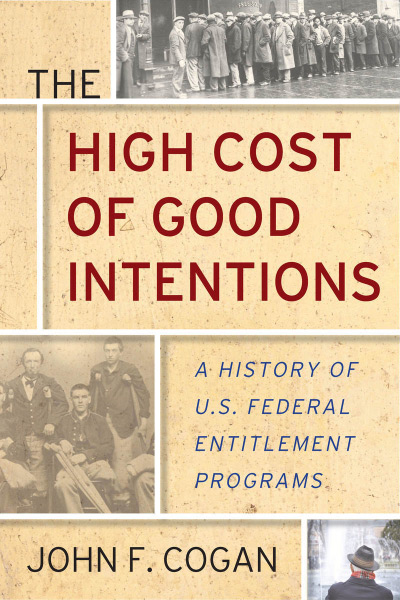In For All of These Rights, Jennifer Klein offers an informative narrative of the rise of private pensions, health insurance, and other insurance-based employment benefits. In addition, she documents many of the interest-group struggles between the American Medical Association (AMA), employers, insurers, unions, and reformers over the public provision of pensions and various forms of insurance. She makes clear her belief that the ideal system is a cooperative system with universal coverage provided through public programs, cooperatives, or unions. Although this viewpoint may be antithetical to many readers of The Independent Review, it would be a mistake to ignore the book on such grounds. I have studied the development of social insurance for more than twenty years, but I learned a great deal from Klein’s research. Further, Independent Review readers will also learn a great deal about the historical facts and the flaws in private insurance that have led Klein and so many other left-liberal scholars to take the positions they do.
I greatly valued several features of the book. The first three chapters offer an excellent history of the Metropolitan Life Insurance Company’s role in developing and expanding group insurance policies between 1910 and World War II. Klein shows that the company played a much larger role than I had previously thought in the area of social-welfare capitalism. It not only offered group insurance to firms, but also actively marketed the benefits of group insurance to the employees who were covered, provided consulting services to firms to help them better design their personnel relations, and often invested in a number of the companies. The consulting services provided through the Policyholders’ Services Bureau (PSB) were designed both to protect Metropolitan Life’s investments and to improve employee relations in ways that would reduce health problems and other factors that might cause losses on their group insurance policies. Metropolitan Life survived the 1929 crash well because it was legally required to hold bonds, not stocks, and it liquidated large holdings before confidence in the bond market had dropped. The company was successful during the 1930s in offering new, fully insured pension programs and in getting many companies to transfer their prior pay-as-you-go policies to more fully insured, actuarially sound policies. Later chapters in Klein’s book show how Metropolitan Life and other insurers developed group health insurance policies.
The political struggles over public policy described in the book are more standard fare. Klein documents the AMA’s continued intransigence against public health insurance and cooperative schemes. She offers informative narratives of the interest-group struggles between unions, insurers, employers, and reformers over various social insurance policies and the regulation of private policies. Weakening unions and communitarian reformers generally did not succeed as much as Klein would have liked.
Reading the book offered me a lesson in perspective. Klein’s perspective seems to be to compare the private and social insurance systems in place at various times throughout the twentieth century to an ideal situation in which everybody pays the same premium, there is universal coverage, and unions and individuals can obtain the coverage they demand at that time. As an economist and an economic historian, I would have emphasized how the innovations in insurance substantially improved the workers’ lot relative to what they had before. Further, I would have used the economics of insurance to illustrate the problems faced by all insurers, whether public or private.
The economics of insurance suggests several key features to keep in mind. Insurance is essentially a way of pooling risk. Forget about insurance companies for the moment and think about a group of people who get together to pool their risks by contributing to a fund to help the group members struck by misfortune. The insurance pool will work best when people with similar and knowable risks form the pool and contribute amounts equal to their expected loss (value of damage multiplied by the probability that damage will occur). They also need to make sure that their risks are not correlated because an epidemic among the members of a sickness fund would quickly exhaust the pooled funds. If the pool has enough people, the laws of probability will allow the system to work well. An insurance pool will not work well if people have different risks but do not pay different premiums. If the members’ risks vary greatly and they have no way of knowing the differences, the pool will fail because of “adverse selection” as the people with high risks stay in the pool and those with low risks drop out, and therefore the contributions are insufficient to cover all of the payouts. Insurance pools require participants to share the costs of treatment through co-payments or deductibles in order to deal with the problem of “moral hazard”: insured people have incentives to take less care, or, in other words, to overuse their privileges. Finally, in the labor market, it is important to look at the total package of wages and benefits workers receive as well as at the premiums and taxes they pay. A rise in the net value of the package makes workers better off, but in some settings an improvement in benefits is offset somewhat by lower wages as a compensating difference. One of the great advantages of group insurance is that the workers are better insured at lower cost than they would be if they bought individual policies. Thus, they are better off even if they pay fully for group insurance either by paying the premiums or by receiving lower wages.
Although Klein does not use these concepts, her book is full of examples that illustrate the economics of insurance. Chapter 2 illustrates the standard adverse selection problems faced by fraternal societies and other union pension funds in first half of the twentieth century. As the members in the societies aged and the odds of paying pensions and benefits rose, the societies started to fail because younger workers refused to join and effectively subsidize their older colleagues. The pre-1930s pay-as-you-go employer pension programs worked somewhat better because by covering nearly the whole payroll they could better manage the ratio of young to old workers. Many of these programs, however, did not hold reserves, and Klein documents that the potential for companies to fail to pay benefits was realized in a number of cases. The group insurance pension plans were better protected because the premiums collected had to be built up into reserves. However, the higher costs and insurance companies’ demands that workers pay part of the premiums often led many employers to avoid these plans. One of the big benefits of the changes in the 1930s was the shift by employers into more insurance-based pension funds. As Klein’s later chapters document, however, even some of these funds ran into problems as employers tried to shift to the government their responsibility for the pension and medical programs for retirees.
Economists argue that among the keys to our current system of insurance are the federal income tax breaks for employer-provided insurance. Although Klein mentions this issue, she might well have devoted more space to it. Interested readers should therefore supplement her book by reading Melissa Thomasson’s economic history studies of health insurance (see, for example, “From Sickness to Health: The Twentieth-Century Development of U.S. Health Insurance,” Explorations in Economic History 39 [July 2002]: 233–53; “Early Evidence of an Adverse Selection Death Spiral? The Case of Blue Cross and Blue Shield,” Explorations in Economic History 41 [October 2004]: 313–28; and “The Importance of Group Coverage: How Tax Policy Shaped U.S. Health Insurance,” American Economic Review 93 [September 2003]: 1373–84).
Klein does not pay enough attention to wages and prices and their relationships to the social insurance issues. Compensating wage reductions matched with improved benefits played a key role in the development of workers’ compensation (as shown in Price Fishback and Shawn Kantor, A Prelude to the Welfare State [Chicago: University of Chicago Press, 2000]). Such compensating differences are currently a fact of life in nearly all labor markets.
In her opening and closing chapters, Klein makes clear her strong preference for public health insurance, medical cooperatives similar to health maintenance organizations (HMOs), and the public Social Security system. These programs, however, also have their problems. They are often very expensive and have heavy cross-subsidies between the groups within them. Further, although the public health insurance systems are better at dealing with preventive medicine and minor medical problems, they impose substantial waiting costs on many patients who need elective surgeries, and therefore they have led wealthier people in countries with public health insurance to opt into private coverages. Anybody dealing with an HMO will be aware of the limitations on access to care that arise in managed care. America’s looming problems with Social Security and Medicare as the ratio of elderly to working population continues to rise are well documented in many places. One of the best discussions is The Real Deal, by Sylvester Scheiber and John Shoven (New Haven, Conn.: Yale University Press, 1999).
For All of These Rights is definitely worth reading because of the high quality of the narrative evidence it provides. The book has won two major history book awards for good reason. My suggestions here are intended to expand the lessons to be learned beyond those Klein teaches in the book.
| Other Independent Review articles by Price V. Fishback | |
| Spring 2023 | Career and Family: Women’s Century-Long Journey toward Equity |
| Winter 2000/01 | Calculating Risks: The Spatial and Political Dimensions of Hazardous-Waste Policy |
| Spring 1998 | How Minnesota Adopted Workers’ Compensation |


















